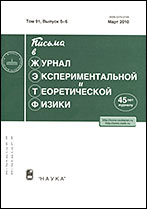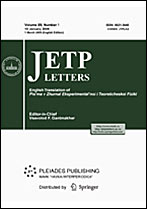|
|
Pis'ma v Zhurnal Èksperimental'noi i Teoreticheskoi Fiziki, 2012, Volume 96, Issue 1, Pages 8–13
(Mi jetpl3160)
|
 |
|
 |
This article is cited in 6 scientific papers (total in 6 papers)
FIELDS, PARTICLES, AND NUCLEI
On the physical meaning of Sachs form factors and on the violation of the dipole dependence of $G_E$ and $G_M$ on $Q^2$
M. V. Galynskiiab, È. A. Kuraevba
a Joint Institute for Nuclear Research, Bogoliubov Laboratory of Theoretical Physics
b Joint Institute for Power and Nuclear Research - Sosny, Minsk
Abstract:
The questions of how a dipole character of the dependence of the form factors $G_E$ and $G_M$ on the square of the momentum transfer to a proton, $Q^2$, arise and why a violation of this dependence occurs, which was first observed in a JLab polarization experiment, are investigated. The answers to these questions could be obtained owing to the use of the simplest QCD concepts of the proton structure and the results obtained by calculating the matrix elements of the proton current in the case of non-spin-flip and spin-flip transitions for protons in the diagonal spin basis (DSB), where the Little Lorentz group common to the initial and final proton states is realized. In DSB, the form factors $G_E$ and $G_M$ are determined by the matrix elements $J^{\delta ,\delta }_{p}$ и $J^{-\delta ,\delta }_{p}$ of the proton current in the cases of non-spin-flip and spin-flip transitions for protons. In an arbitrary reference frame, the relations between these matrix elements and the form factors are $J^{\delta ,\delta }_{p} \sim G_E$ and $J^{-\delta ,\delta }_{p} \sim \sqrt{\tau}\, G_M$ , where $\tau=Q^2/4m^2$, with $m$ being the proton mass. In considering the problem in question at the quark level, use is made of the model where the proton consists of three pointlike quarks having identical masses and where the respective matrix element of the proton current is the product of three quark-current amplitudes having the form $J^{\delta ,\delta }_{q} \sim 1$, $J^{-\delta,\delta }_{q} \sim \sqrt{\tau}$ . It is shown that the aforementioned dipole dependence arises if the proton spin flip is due to spin flip for only one of the three quarks. As to violations of this dependence, they are caused by the contributions to $J^{\delta ,\delta }_{p}$ from spin-flip transitions for two quarks or by the contribution to $J^{-\delta ,\delta }_{p}$ from spin-flip transitions for all three quarks constituting the proton.
Received: 28.05.2012
Citation:
M. V. Galynskii, È. A. Kuraev, “On the physical meaning of Sachs form factors and on the violation of the dipole dependence of $G_E$ and $G_M$ on $Q^2$”, Pis'ma v Zh. Èksper. Teoret. Fiz., 96:1 (2012), 8–13; JETP Letters, 96:1 (2012), 6–12
Linking options:
https://www.mathnet.ru/eng/jetpl3160 https://www.mathnet.ru/eng/jetpl/v96/i1/p8
|


|





 Contact us:
Contact us: Terms of Use
Terms of Use
 Registration to the website
Registration to the website Logotypes
Logotypes








 Citation in format
Citation in format 
